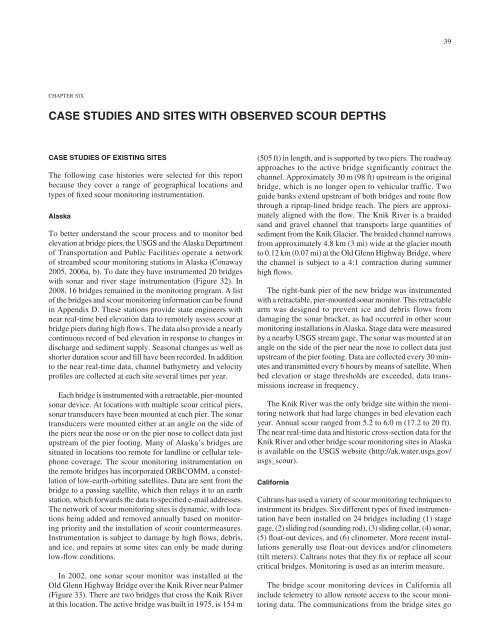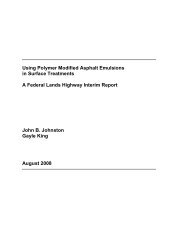NCHRP Synthesis 396 â Monitoring Scour Critical Bridges - TSP2
NCHRP Synthesis 396 â Monitoring Scour Critical Bridges - TSP2
NCHRP Synthesis 396 â Monitoring Scour Critical Bridges - TSP2
Create successful ePaper yourself
Turn your PDF publications into a flip-book with our unique Google optimized e-Paper software.
39<br />
CHAPTER SIX<br />
CASE STUDIES AND SITES WITH OBSERVED SCOUR DEPTHS<br />
CASE STUDIES OF EXISTING SITES<br />
The following case histories were selected for this report<br />
because they cover a range of geographical locations and<br />
types of fixed scour monitoring instrumentation.<br />
Alaska<br />
To better understand the scour process and to monitor bed<br />
elevation at bridge piers, the USGS and the Alaska Department<br />
of Transportation and Public Facilities operate a network<br />
of streambed scour monitoring stations in Alaska (Conaway<br />
2005, 2006a, b). To date they have instrumented 20 bridges<br />
with sonar and river stage instrumentation (Figure 32). In<br />
2008, 16 bridges remained in the monitoring program. A list<br />
of the bridges and scour monitoring information can be found<br />
in Appendix D. These stations provide state engineers with<br />
near real-time bed elevation data to remotely assess scour at<br />
bridge piers during high flows. The data also provide a nearly<br />
continuous record of bed elevation in response to changes in<br />
discharge and sediment supply. Seasonal changes as well as<br />
shorter duration scour and fill have been recorded. In addition<br />
to the near real-time data, channel bathymetry and velocity<br />
profiles are collected at each site several times per year.<br />
Each bridge is instrumented with a retractable, pier-mounted<br />
sonar device. At locations with multiple scour critical piers,<br />
sonar transducers have been mounted at each pier. The sonar<br />
transducers were mounted either at an angle on the side of<br />
the piers near the nose or on the pier nose to collect data just<br />
upstream of the pier footing. Many of Alaska’s bridges are<br />
situated in locations too remote for landline or cellular telephone<br />
coverage. The scour monitoring instrumentation on<br />
the remote bridges has incorporated ORBCOMM, a constellation<br />
of low-earth-orbiting satellites. Data are sent from the<br />
bridge to a passing satellite, which then relays it to an earth<br />
station, which forwards the data to specified e-mail addresses.<br />
The network of scour monitoring sites is dynamic, with locations<br />
being added and removed annually based on monitoring<br />
priority and the installation of scour countermeasures.<br />
Instrumentation is subject to damage by high flows, debris,<br />
and ice, and repairs at some sites can only be made during<br />
low-flow conditions.<br />
In 2002, one sonar scour monitor was installed at the<br />
Old Glenn Highway Bridge over the Knik River near Palmer<br />
(Figure 33). There are two bridges that cross the Knik River<br />
at this location. The active bridge was built in 1975, is 154 m<br />
(505 ft) in length, and is supported by two piers. The roadway<br />
approaches to the active bridge significantly contract the<br />
channel. Approximately 30 m (98 ft) upstream is the original<br />
bridge, which is no longer open to vehicular traffic. Two<br />
guide banks extend upstream of both bridges and route flow<br />
through a riprap-lined bridge reach. The piers are approximately<br />
aligned with the flow. The Knik River is a braided<br />
sand and gravel channel that transports large quantities of<br />
sediment from the Knik Glacier. The braided channel narrows<br />
from approximately 4.8 km (3 mi) wide at the glacier mouth<br />
to 0.12 km (0.07 mi) at the Old Glenn Highway Bridge, where<br />
the channel is subject to a 4:1 contraction during summer<br />
high flows.<br />
The right-bank pier of the new bridge was instrumented<br />
with a retractable, pier-mounted sonar monitor. This retractable<br />
arm was designed to prevent ice and debris flows from<br />
damaging the sonar bracket, as had occurred in other scour<br />
monitoring installations in Alaska. Stage data were measured<br />
by a nearby USGS stream gage. The sonar was mounted at an<br />
angle on the side of the pier near the nose to collect data just<br />
upstream of the pier footing. Data are collected every 30 minutes<br />
and transmitted every 6 hours by means of satellite. When<br />
bed elevation or stage thresholds are exceeded, data transmissions<br />
increase in frequency.<br />
The Knik River was the only bridge site within the monitoring<br />
network that had large changes in bed elevation each<br />
year. Annual scour ranged from 5.2 to 6.0 m (17.2 to 20 ft).<br />
The near real-time data and historic cross-section data for the<br />
Knik River and other bridge scour monitoring sites in Alaska<br />
is available on the USGS website (http://ak.water.usgs.gov/<br />
usgs_scour).<br />
California<br />
Caltrans has used a variety of scour monitoring techniques to<br />
instrument its bridges. Six different types of fixed instrumentation<br />
have been installed on 24 bridges including (1) stage<br />
gage, (2) sliding rod (sounding rod), (3) sliding collar, (4) sonar,<br />
(5) float-out devices, and (6) clinometer. More recent installations<br />
generally use float-out devices and/or clinometers<br />
(tilt meters). Caltrans notes that they fix or replace all scour<br />
critical bridges. <strong>Monitoring</strong> is used as an interim measure.<br />
The bridge scour monitoring devices in California all<br />
include telemetry to allow remote access to the scour monitoring<br />
data. The communications from the bridge sites go
















